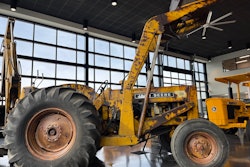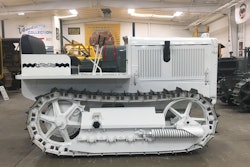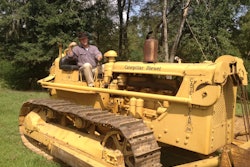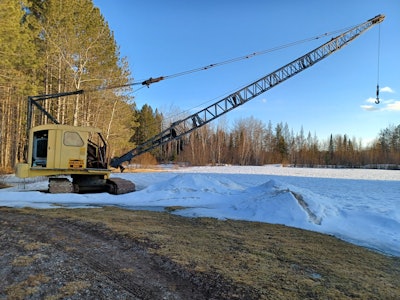
Hydraulic excavators hold no appeal for Francis Robertson. He’ll take a friction dragline hands-down any time.
“I relax on them,” he says. “That's what I love about them. I relax when I'm running them.”
At 83 years old, cable-operated cranes have been a part of Robertson’s life for 60 years, from his time in the Navy until retirement to his farm in Hibbing, Minnesota. There, he has two 1961 American 399-BC crawler cranes he has restored and uses for small tasks.
“It's the motion of it,” he says in explaining his love for the old American cranes. “You pull a lever, and you see that bucket coming through. You think about how much work you'd have to do if you're doing it with a shovel, and here you're just pulling on a lever and that bucket’s coming through water and mud – and up in the air it goes.
“And then the sound of a nice-running diesel. Like guys who like driving Harley Davidsons.
“Listening to the Harley Davidson rumble is for me on a dragline.”
A Seabee meets the cranes
Robertson was first introduced to crawler cranes in 1962 after he enlisted and was assigned as a mechanic in the Seabees, the construction battalion of the U.S. Navy.
“I didn’t get to operate them,” he says. “They wanted me to turn wrenches instead.”
After the Navy, he became an equipment operator and late formed his own construction and real estate development company.
“At that time, in the early ’60s, the crane was the most valuable piece of equipment that a person in construction could own,” he recalls. “You could have it as either a crane, or put a bucket on it and it's a dragline, or a piledriver – so many things you could do with it.”
American lattice-boom crawler cranes were well-known at that time and had a long history that extended into the 1980s.
The company traced its roots to 1882 with the founding of the Franklin Manufacturing Company in St. Paul, Minnesota. It changed names over the years and also changed with the industry, manufacturing friction drums for hoisting equipment, then steam-powered hoists and electric hoists. The company created the first crawler crane in 1923.
In 1985, the American crane mobile product line was purchased by a group of investors who formed the American Crane Corporation. Three years later, that company was acquired by Terex, according to the Terex website.
Workers' lives in his … feet
In the 1980s, Robertson’s company branched out into some heavy demolition jobs, on which he would use a Lima 44 lattice-boom crawler crane. He would also operate the friction crawler cranes for tasks that construction firms now use hydraulic aerial lifts for.
“I used to have people in a man basket where I would lift them up,” he recalls. “And I don't know if they fully realized how their life was at stake on just my right foot holding a brake. If my foot would have slipped, they would have been dead.”
Operating the machines required a great deal of skill and was physically taxing. It seemed to come from a natural talent operators either had or they didn’t.
“It's been known by most all operators that you just have to have a feel for it,” he says. “Some never can get the hang of it, and then others just take to it like a duck to water. And I was fortunate to be one of those that took to it.”
No fan of hydraulics
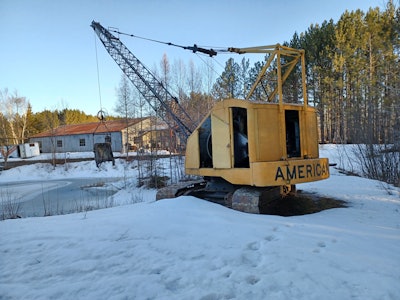 Francis Robertson's other 1961 American 399-BC crane is equipped as a dragline.Francis Robertson
Francis Robertson's other 1961 American 399-BC crane is equipped as a dragline.Francis Robertson
He bought his first 1961 American 399-BC crawler crane in the mid-1990s for digging ponds and other projects on his farm.
His second crane came around 2001 when he bought what became more than he bargained for.
“I didn't realize what I was getting really,” he says. “It was so rusted up. I had to do a tremendous amount of work on it.”
After several months of restoration and buying additional boom, he got the crane in top condition.
The cranes run on 4-71 Detroit Diesel engines and weigh around 25 tons. One has a dragline on it, and the other is outfitted as a crane.
He says they don’t require much maintenance, mostly just keeping the moving parts and cables lubricated.
But the simple ends there when compared to hydraulic excavators. Robertson, however, has no interest in a modern machine.
“It’s so simple to operate,” he says. “There’s no challenge to it at all.”
Keeping it all in the air
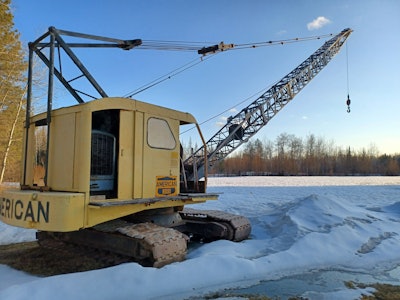 Francis Robertson
Francis Robertson
Robertson describes it this way:
“With the 4-71 Detroit Diesel, all you have to do is push a button to start it.
“And then once it starts, you engage your master clutch, and when your master clutch is engaged, you can put all your functions into work.
“You have to switch it either from propel or to swing. You’ve got a swing lever. You’ve got another lever that pulls the dragline cable. If you’ve got it equipped as a dragline, then you’ve got your hoist lever that lifts things. You have two brakes that hold those winches once you pull them into position and hold them.
“You have to keep tension on your cables all the time. Otherwise, you’ll get just like a fishing-reel backlash. You’ll have cables all over the place, and it makes a mess. You have to pull them all out and have some tension on them, so you can reel them back in in order again.”
Remembering the days of friction
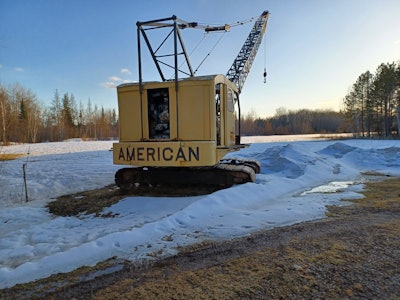 Francis Robertson's 1961 American cable cranes run on 4-17 Detroit Diesel engines.Francis Robertson
Francis Robertson's 1961 American cable cranes run on 4-17 Detroit Diesel engines.Francis Robertson
They run well, but their drive system is weak, he says. They’re also harder to work on.
He’d like to get his hands on a Bucyrus-Erie 30B, which he calls the “Cadillac of cranes.”
“But they’re impossible to find here anymore,” he says. “The cable machines are almost nonexistent, around here anyway.”
Drive system aside, he loves his cable-operated cranes, especially their name.
“I like to look at it in my yard and see the sign 'American' on it on the back,” he says. “I’ve got it parked so that when somebody drives by, they can look down our driveway and see the big 'American' on the counterweight of it.”
They're also reminders of a bygone era in construction history, a time Robertson remembers fondly.
“The older days when you had to have some skill to work things,” he says, “I miss those days.”





